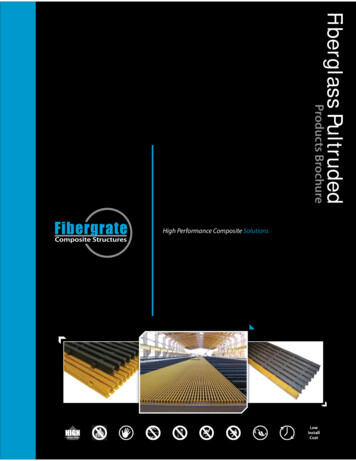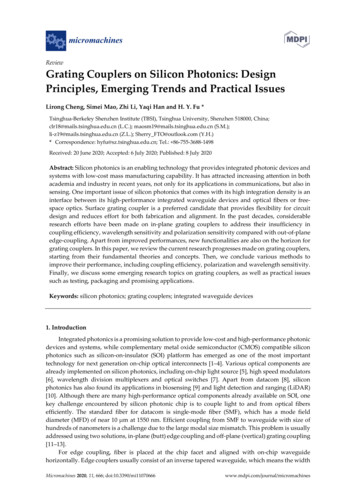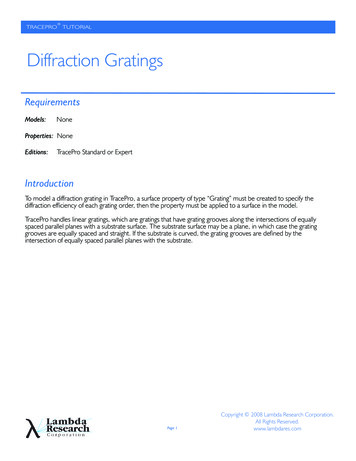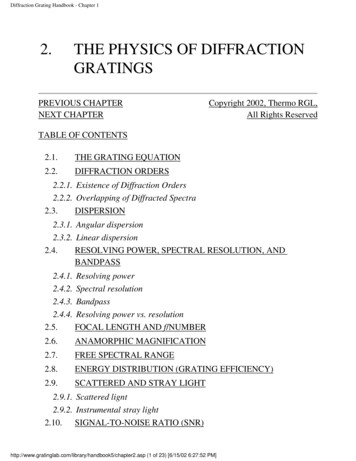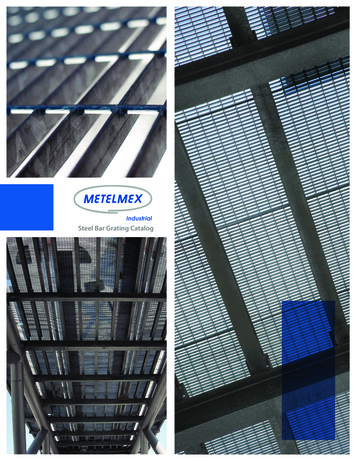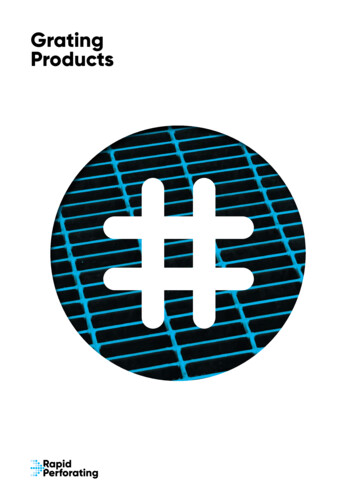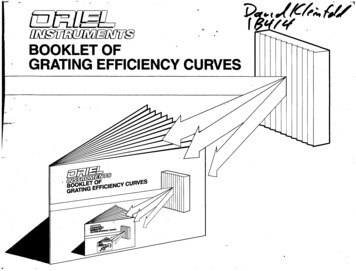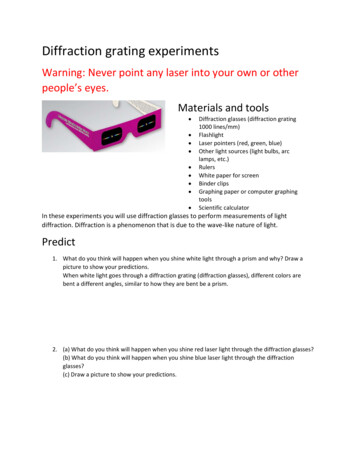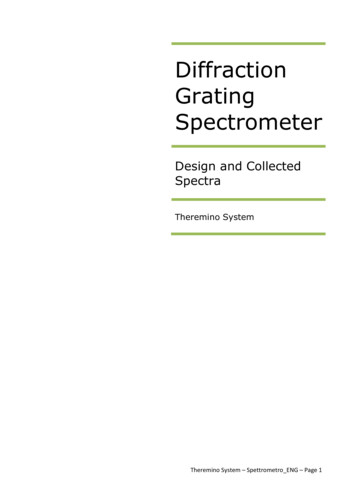
Transcription
DiffractionGratingSpectrometerDesign and CollectedSpectraTheremino SystemTheremino System – Spettrometro ENG – Page 1
Table of contentsDesign and Components. 6Theory of Diffraction Grating . 6Diffraction Grating Specifications . 8Portable Spectrometer Construction . 9Benchtop Spectrometer Construction. 10Spectra of Lamps . 11Spectral Lamps. 14Hydrogen . 14Carbon Dioxide . 15Nitrogen . 15Spectra of Flames and Plasma . 16Emission and Atomic Absorption spectra. 17LED Spectra . 18Laser Spectra . 20Sun Spectrum . 22Wien Law / Black body radiation . 24Comparison with Reference Spectra . 25CFL Lamp. 25Neon Lamp . 26Sodium-vapor Lamp. 27Absorption Spectroscopy . 28Absorption Spectrometer Design . 28Water . 29Red Wine . 29Blue Food Dye. 30Yellow Food Dye . 30Blue Ink . 30Fluorescence Spectroscopy . 31Fluorescence Spectrometer Design . 31Fluorescence Excitation Sources . 32Fluorescence Theory . 33Spectroscopy of Organic Pigments . 35Chlorophyll . 35Theremino System – Spettrometro ENG – Page 2
Phycoerythrin . 37Anthocyanins as pH Indicator . 38Carotenoids . 40Betalaine . 41Spectroscopy of Fluorescent Dyes. 43Stilbenes – Triazine (Optical Brightener) . 43Fluorescein Sodium (Uranine) . 44Eosin . 45Acridine Orange . 46Rhodamine B . 47Rhodamine 6G . 48Green Fluorescent Dye . 49Methylene Blue . 50Crystal Violet. 51Methylene Blue – Malachite Green – Crystal Violet – Acriflavine (Preparation for Fungal infections) . 52Phthalocyanine . 53Erythrosine . 54Coumarin . 55Spectroscopy of Edible Oils . 56“Extra Vergine” Olive Oil . 56Peanut Oil . 57Sunflower Oil . 58Corn Oil . 58Soybean Oil . 58Almond Oil . 59Sesame Oil . 59Castor Oil . 59Spectroscopy of Vitamins . 60Cyanocobalamin (Vitamin B12) . 60Riboflavin (Vitamin B2) and Pyridoxine (Vitamin B6) . 61Retinol (Vitamin A) . 61Spectroscopy of Food Substances . 62White Wine . 62Wine Vinegar . 62Isoflavones (Soy Sauce) . 63Theremino System – Spettrometro ENG – Page 3
Green Walnut Extract (Liqueur Nocino) . 63ProtoPorphyrin (Egg Shell) . 64Honey. 65Rose Siroop . 66Rhubarb Extract . 66Ale Beer . 67Dark Beer . 67Stout Beer . 67Pistachio Extract . 68Green Tea . 68Spectroscopy of Drugs . 69Hematoporphyrin . 69Sodium Salicylate . 70Piroxicam . 71Spectroscopy of Various Compounds . 72Pyranine . 72Perfume . 72Bleaching Detergent . 72Methyl Salicylate . 73Quinine . 73Urine . 74Hemoglobin . 75Gasoline . 76Anthracene . 76Tetracene (Naphthacene). 77Motor Oil . 77Bergamot Essential Oil. 78Chamomile Essential Oil . 79Orange Essential Oil. 80Orange Blossoms Water . 80Curcumin Essential Oil . 81Spectroscopy of Inorganic Compounds . 82Strontium Aluminate . 82Uranium glass . 83Halogen Inner Bulb . 83Theremino System – Spettrometro ENG – Page 4
LYSO Scintillator Crystal . 83Raman Spectroscopy . 84Chemiluminescence Spectroscopy . 85Blue LightStick . 86Green LightStick. 86Yellow LightStick . 86Purple LightStick . 87Orange LightStick . 87Red LightStick . 87Spectroscopy of Quantum Dots . 88Optical Properties . 88Adopted Quantum Dots . 89CdTe Hydrophilic Quantum Dot – Green. 90CdTe Hydrophilic Quantum Dot – Yellow . 90CdTe Hydrophilic Quantum Dot – Orange . 91CdTe Hydrophilic Quantum Dot – Red . 91CdTe Hydrophilic Quantum Dot – Dark Red . 92Theremino System – Spettrometro ENG – Page 5
Design and Components Webcam : NEW TRUST MEGAPIXEL WEBCAM PRO 1.3MP 1024x1280Diffraction gratings : holographic 1000 linee/mm – 600 linee/mmCollimating lensslit 100micron / slits 0.1–0.5-1mm built with razor blades / micrometric adjustable slitPortable SpectrometerTheory of Diffraction GratingA monochromatic light beam that is incident on a grating gives rise to a transmitted beam and variousdiffracted beams , at angles that depend on the ratio between the distance between the lines of the gratingand the wavelength of the light.So, if the light beam is composed of multiple wavelengths, the decomposition of the beam into itscomponents is obtained.The light with a longer wavelength is deflected to a larger angle with respect to the incident direction(angle of diffraction ) . For each wavelength more rows can be observed. The number of rows that arecounted from the middle line, which is not skewed with respect to the incident beam and is taken as areference , it is said "order" and is often denoted by the letter m.The diffraction gratings can act both for transmission and for reflection of the incident light depending onthe light scattering takes place on the same side or the opposite side of the light source . The transmissiongratings are composed of a transparent plate on which are created many small strips that do not allow thepassage of the radiation. In this way you get many small slits whose figure generated on a screen is solvedby a method analogous to that used for the interference .The reflection gratings are constituted by a reflective layer (mirror) on which are created many small stripsor grooves that do not allow the reflection of the radiation. They are used in monochromators andspectrometers .The distance between the slits, known as "grating pitch" , in the gratings used in spectroscopy is of thesame order of magnitude as the wavelength of the light to be analyzed . In practice, the patterns areusually characterized by the number of engravings per unit length , often expressed in lines per millimeter(l/mm).Theremino System – Spettrometro ENG – Page 6
The fundamental property of the gratings is that the angle of deviation of all the refracted beams dependson the wavelength of the incident light. Thus, a grating separates a beam of polychromatic light in itswavelengths components, so the grating is a dispersive tool.When a light beam is incident on a grating is diffracted in different beams. The beam corresponding to thedirect transmission is called zero-order diffraction . The convention in use denote the not deflected beamwith m 0 . Respect to the direction identified by the reference beam is possible to measure the diffractionangle that characterizes each deflected beam . m can assume positive or negative values depending on thatthe deflected beam is to the right or left of the zero order beam (this depends on the convention used forthe sign of the angles).Denoting by d the grating pitch and λ the wavelength of the incident radiation can be written :When the beam hits at angle θi the grating. The sign in the formula depends on the choice of theConvention on the sign of the angles.From the previous relation it can be seen that a beam of polychromatic light is divided into its componentsfrom violet ( which is the color characterized by shorter wavelength ) till to red; instead in a glass prism theangle of deviation is greater for violet, so the sequence of colors is reversed.Comparison between the spectra obtained from a diffraction grating (1), andfrom a refraction prism (2). Longer wavelengths (red) are deflected more,while the shorter ones (violet) are deflected less.The light from a lamp seen through a transmission grating which showsthree diffraction orders. The order m 0 corresponds to the directtransmission through the grating.In the first positive order (m 1), colors with longer wavelength (from violet to red) are deflected athigher angles.The diffracted beams of different colors and corresponding to consecutive orders can overlap, thisphenomenon becomes more likely to grow in the order of diffraction. Moreover, in an experiment theobserved diffraction lines are never infinitely narrow ( as expected from the theory ) , this phenomenon is aconsequence of the not ideal experimental conditions and because of the Doppler effect.The equation of the grating shows that the diffraction angle depends only on the pitch of the grating andnot by the shape of the slits. The efficiency of the grating can also depend on the polarization of theincident light .Theremino System – Spettrometro ENG – Page 7
Diffraction Grating SpecificationsType fraction for different 4Gratings in useHolographic grating with 1000 lines/mm and holographic Paton grating with 600 lines/mmPortable Spectrometer Design :Grating40oSlitWebcamBenchtop Spectrometer Design :Collimator lensWebcamGratingSlitWebcam LensTheremino System – Spettrometro ENG – Page 8
Portable Spectrometer ConstructionGratingWebcamDetails of webcam and diffraction grating0.1mm slit, 0.5mm slit and 1mm slitScattering screenTheremino System – Spettrometro ENG – Page 9
Benchtop Spectrometer ConstructionLensWebcamGratingInside view with collimating lens, grating and webcamSlitDetail of the micrometric slit and the spectrometer assembledCalibration CFL lampTheremino System – Spettrometro ENG – Page 10
Spectra of LampsInfrared LinesCFL lamp just lit – presence of lines broadened by phosphorus – infrared emission (λ 750nm)436nm546nm576nm579nmCFL lamp after warm-up (detail 400nm – 800nm) – no infrared emissionTheremino System – Spettrometro ENG – Page 11
Incandescent lamp 25W – continuous spectrum with maximum at 800nmHalogen lamp 70W – continuous spectrum – more emission at shorter λ (temperature is increased)Low pressure neon lamp – discrete spectrum with many narrow linesWood lamp – UV emission at 370nm with tinyvisible “tail” beyond 380nmTheremino System – Spettrometro ENG – Page 12
Sodium-vapor lamp (street lamp) – evidence of the sodium double absorption line at a 589nm – furtherlines at 568nm, 616nm, 514nm, 498nm all corresponding to emission lines of the sodium spectrumXenon lampDue to the broad extension of the emission, from 350nm to 950nm, this lamp is used in absorption andfluorescence spectroscopyTheremino System – Spettrometro ENG – Page 13
Spectral LampsHydrogenHαHβPaschen LineLow pressure hydrogen spectral lamp with high voltage high frequency power supply.The main hydrogen emission lines are evident.Detail of hydrogen Hβ line (486nm)Detail of hydrogen Hα line (656nm) dell’idrogenoTheremino System – Spettrometro ENG – Page 14
Carbon DioxideLow pressure carbon dioxide spectral lamp with high voltage high frequency power supply.The main carbon dioxide emission lines are evident.NitrogenLow pressure nitrogen spectral lamp with high voltage high frequency power supply.The main nitrogen emission lines are evident.The second spectrum has been acquired with a broader slit in order to show more emission lines.Theremino System – Spettrometro ENG – Page 15
Spectra of Flames and PlasmaCandle – emission mainly at longer wavelengthsPlasma from high voltage arc – great emission of UV radiationAtmospheric nitorgen emission spectrum (fromreference spectra). Corespondance of the emissionpeaks at 400nm and 430nm. Thus we can infer thatthe plasma emission is mainly due to the nitrogenemission.Theremino System – Spettrometro ENG – Page 16
Emission and Atomic Absorption spectraSodium doubletIn the first spectrum of HV plasma with sodium chloride is evident the sodium line at 589nm. In thesecond spectrum the detail shows the sodium doublet at 589,0nm and 589,6nm. The third and fourthspectra show the detail of the absorption line in a sodium-vapor lampPotassium doubletSpectrum of potassium chlorate match – evidence of potassium doublet at 770nmTheremino System – Spettrometro ENG – Page 17
Sodium emission590nmPotassium emission770 and 780nmHV plasma spectrum with sodium and potassium emission lines overlapping thermal backgroundLED SpectraInfrared LEDRed LEDYellow REDTheremino System – Spettrometro ENG – Page 18
Green LEDBlue LEDViolet LEDWhite LED “cold light”Theremino System – Spettrometro ENG – Page 19
Laser SpectraViolet laser diode 410nmRed laser diode – emission 650nmIR laser diode – emission 780nmTheremino System – Spettrometro ENG – Page 20
Green laser diode – detail of the emission line with two peaks at 532 and 530nmGreen laser diode – the pumping emission lines are shown532nm green laser diode functioning scheme. There is IR pumping emission at 800nm. Nd:YVO4 crystalconverts this wavelength into 1064nm emission, the latter is frequency-doubled, at 532nm, from a KTPcrystalTheremino System – Spettrometro ENG – Page 21
Sun SpectrumO2 AtmH2O AtmO2 AtmHγHβMgNaFeHαSun spectra at different timesTheremino System – Spettrometro ENG – Page 22
Maximum at 530nm T 5500Ko (from black body radiation / Wien law)Evidence of UV ( 400nm) and IR ( 750nm)Evidence of the following absorption bands / lines : Atmospheric oxygen absorption band O2 760nm – Fraunhofer A Atmospheric water vapor absorption band 720nmAtmospheric oxygen absorption band O2 684nm – Fraunhofer B Absorption Hα 657nm (Balmer series) Fraunhofer CAbsorption Hβ 480nm (Balmer series) Fraunhofer FAbsorption Hγ 430nm (Balmer series) Fraunhofer GSodium absorption line at 589nm Fraunhofer DIron absorption line at 530nm Fraunhofer EMagnesium absorption line at 520nm Fraunhofer bFraunhofer main linesSun spectrum 650nm - 800nm with absorption bands of atmospheric gasesTheremino System – Spettrometro ENG – Page 23
Wien Law / Black body radiationWien's displacement law states that the black body radiation curve for different temperatures peaks ata wavelength inversely proportional to the temperature. The shift of that peak is a direct consequence ofthe Planck radiation law which describes the spectral brightness of black body radiation as a function ofwavelength at any given temperature. However it had been discovered by Wilhelm Wien several yearsbefore Max Planck developed that more general equation, and describes the entire shift of the spectrum ofblack body radiation toward shorter wavelengths as temperature increases.,Sun spectrum with absorption bands ofatmospheric gasesTheremino System – Spettrometro ENG – Page 24
Comparison with Reference SpectraCFL LampPeak numberWavelength of peak(nm)Species producing peakActual line location (nm)1405.4mercury402 - 28584.09587.6Mercuryterbium from Tb3 terbium from Tb3 Mercurylikely terbium from Tb3 ormercurymercury or terbium fromTb3 possibly terbium fromTb3 or europium inEu 3:Y2O3likely europium in Eu 3:Y2O3576579584587Theremino System – Spettrometro ENG
on the wavelength of the incident light. Thus, a grating separates a beam of polychromatic light in its wavelengths components, so the grating is a dispersive tool. When a light beam is incident on a grating is diffracted in different beams. The beam corresponding to the direct transmission is called zero-order diffraction .
